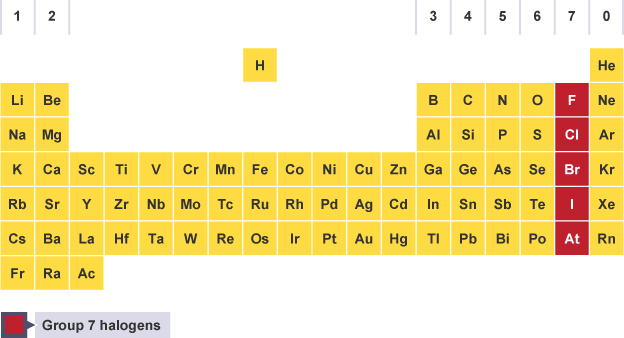Chemistry - Halogens
The Halogens are in Group 7 in the periodic table because they have 7 electrons in the outer shell. Group 7 elements form salts when they react with metals. The term ‘halogen’ means ‘salt former’.

Properties
Halogens has properties of typical non metals i.e
Poor conductors of electricity and heat
Low density
Low melting/ boiling point
Differentiating halogens
All of the halogens exist as diatomic molecules. This means that the elements are made up of pairs of atoms that are chemically joined together (for example, fluorine exists as F2, chlorine as Cl2, bromine as Br2 and iodine as I2).
Iodine forms a purple vapour when it is warmed.
Name | Formula | State at room temp | Colour of vapour | Melting point (C0)| Boiling point
Fluorine Fl2. Gas yellow -220 -188
Chlorine Cl2. Gas yellow -101 -34
Bromine Br2. Liquid orange/brown -7 +58
Iodine I2. Solid purple/grey +114 +183
To differentiate different halogens look at physical properties such as:
State at room temp - There is a trend in state from gas to liquid to solid as you go down the group.
Colour - The halogens become darker as you go down the group.
Melting points - The melting and boiling points then increase as you go down the group.
Halogens with iron
Chlorine and iron
Needs small amount of heat to violently react producing Iron (III) chloride
Iron + chlorine → iron(III) chloride
2Fe + 3Cl2 → 2FeCl3
Bromine and iron
Immediately forms vapour, needs small amount of heat to react, quick but slower than chlorine and visible reaction producing Iron (III) bromide
Iron + bromine → iron(III) bromide
2Fe + 3Br2 → 2FeBr3
Iodide and iron
Produces purple vapour, needs several minutes of heating creating Iron (III) iodide
Iron + iodine → iron(III) iodide
2Fe + 3I2 → 2FeI3
Reactivity
Halogens decrease in reactivity as you go down the group. This is the opposite trend to that seen in the alkali metals in Group 1. Outer shell gets nearer to the nucleus so easier to attract one electron. Fluorine is the most reactive element of all in Group 7.
Displacement reactions
A more reactive halogen displaces a less reactive halide ion from its solution.
Uses of the Halogens
Chlorine - water supplies, swimming pools, bleaches
Bromide - plasters, sterilising sprays
Iodide - antiseptic
Safety precautions
• Fume cupboard used for reactions – halogens produce toxic vapours.